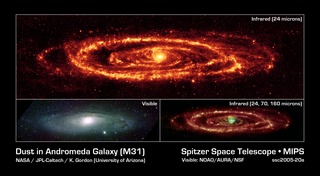
Credit: NASA/JPL-Caltech/K. Gordon (University of Arizona)
Observation • October 13th, 2005 • ssc2005-20a1
ssc2005-20a1
NASA's Spitzer Space Telescope has captured stunning infrared views of the famous Andromeda galaxy to reveal insights that were only hinted at in visible light.
This Spitzer's 24-micron mosaic is the sharpest image ever taken of the dust in another spiral galaxy. This is possible because Andromeda is a close neighbor to the Milky Way at a mere 2.5 million light-years away.
The Spitzer multiband imaging photometer's 24-micron detector recorded 11,000 separate snapshots to create this new comprehensive picture. Asymmetrical features are seen in the prominent ring of star formation. The ring appears to be split into two pieces, forming the hole to the lower right. These features may have been caused by interactions with satellite galaxies around Andromeda as they plunge through its disk.
Spitzer also reveals delicate tracings of spiral arms within this ring that reach into the very center of the galaxy. One sees a scattering of stars within Andromeda, but only select stars that are wrapped in envelopes of dust light up at infrared wavelengths.
This is a dramatic contrast to the traditional view at visible wavelengths, which shows the starlight instead of the dust. The center of the galaxy in this view is dominated by a large bulge that overwhelms the inner spirals seen in dust. The dust lanes are faintly visible in places, but only where they can be seen in silhouette against background stars.
The data were taken on August 25, 2004, the one-year anniversary of the launch of the space telescope. The observations have been transformed into this remarkable gift from Spitzer -- the most detailed infrared image of the spectacular galaxy to date.
About the Object
- Name
- Andromeda Galaxy • Messier 31 • M31 • NGC 224
- Type
- Galaxy > Type > Spiral
- Distance
- 2,500,000 Light Years
Color Mapping
| Band | Wavelength | Telescope |
| Infrared | 24.0 µm | Spitzer MIPS |
Astrometrics
- Position (J2000)
- RA =0h 42m 44.3s
- Dec = 41° 16' 6.2"
- Field of View
- 2.8 x 0.8 degrees
- Orientation
- North is 53.0° left of vertical







